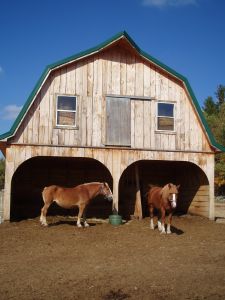If you build it, they will come. This is true for a baseball field in Field of Dreams and true for the farm where you build your horse business. One of the hardest lessons you learn in the business of raising horses is that you are raising more than horses. You’re raising the roof on a barn or a run in shed, you’re raising grass and you’re raising more weeds than you can name readily.

From a worker’s standpoint, that means you wear almost as many hats as you do when you are raising children. But in essence, that’s what raising horses is. You’re raising your four legged children and you want for them what you want for children at home.
For example, the first year of a horse’s life involves vaccinations and training. While they may not need their diapers changed or their withers held while they learn to walk, they do have to learn what it is to wear a halter, what a lead rope is and just like weaning a baby from a bottle of formula to a solid food meal, you watch as the foal learns to eat grain and grass.
Here’s where the raising grass part comes in. There’s dozens of different types of grass you may find on your property from orchard to bluegrass to rye to fescue. There are more types of grass than I can name or recognize. I never imagined when I first owned a pair of horses that someday I would want to know one blade of grass from another. But in the business of horse raising, you want to know what type of grass you have so that you know what types of endophytes and fungus you might develop which can impact your horses.
That being said, you also want to have adequate shelter for the horses both in and out of the pasture. Pasture shelter can range from run ins to a good bracing of woods. The trees will provide shelter from direct sunlight, allowing horses to stay cooler, and in some cases may even provide a good wind brace and rain shield, but not entirely.
Run ins offer the best protection from the wind and the elements because horses can tuck themselves away in them at will. They aren’t shut in, but they also aren’t shut out. The shelter from the elements is every bit as important in the hot, humid days of summer as it is in the cold, drizzly days of winter.
But there are times when even the run-ins don’t do. In those instances, you need a good solid barn without leaks and closeable windows. When you have an age span reaching between a few months old and approaching twenty-five years old, you will find that some horses have trouble regulating their body temperature. Older horses can get chilled and sick very easily, much like elderly humans. Young horses, not as used to the elements as their older companions, can suffer similarly.
These animals need the protection of a good warm stall on frigid nights and fan cooled stalls on blistering days. When the snow is three feet deep or the rain hasn’t stopped for days and might chill a horse to the bones as their undercoats get soaked, you also want to be able to stall them up to keep them comfortable.
A good solid barn is the easy solution. You want a stall with a feed dish, fresh water and either sawdust or straw (I prefer sawdust) for good footing and cushioning. Horses like to lie down and rest as much as they do sleep while standing. When they are standing in a 12×12 stall for any length of time, it’s better for them to have a good cushion underneath their legs and their body.
A lot of this becomes rote as you go along, taking care of your animals. Much as your routine every morning may consist of putting on the coffee pot and taking out the garbage, your routine with the horses will include checking the fence lines, the run-in conditions, the water level and the readiness of stalls.
And as the seasons change, the grass is an ever-present companion to the art of raising the horse. Whether you are bush-hogging, mowing, or seeding. The grass, however, is not alone. The grass is joined by the weeds that spread like – well, weeds. With all the varieties of weeds there are some are good for the pastures and some are just plain trouble. The war on weeds is one that you hold an ever present front against whether it’s summer or winter. You maintain that front while advancing the growth of the grass. You want to know what type of grass in what season and what needs to be done with it.
These are all tricks of the trade and they all fall into the category of maintenance. But make no mistake, they are crucial tasks in the business of raising horses and a horse-raiser is a jack of many trades, whether its grass, weeds, barns or fences.

